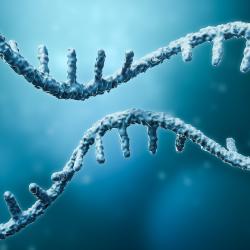UMD-led Study Could ‘Pave the Way’ for Improved Treatment of Premature Aging Disease
Researchers identified a protein that could improve the cardiovascular health of patients with progeria.
A new University of Maryland-led discovery could spur the development of new and improved treatments for Hutchinson-Gilford progeria syndrome (HGPS), a rare genetic disorder with no known cure that causes accelerated aging in children.

Published in the journal Aging Cell on October 18, 2024, in collaboration with researchers from the National Institutes of Health (NIH) and Duke University, the study identified a protein linked to the cardiovascular health of animal models with progeria that could translate to human treatments. Heart failure and stroke are the most common causes of death for people with HGPS, who typically have a life expectancy between 6 and 20 years old.
These new findings from the lab of UMD Cell Biology and Molecular Genetics Professor Kan Cao are “highly promising,” according to lead author and biological sciences Ph.D. student Sahar Vakili.
“This could pave the way for new treatments targeting cardiovascular complications in HGPS, which are currently a major cause of mortality in the affected children,” Vakili said. “Beyond progeria, insights gained from this research might also be applicable to other age-related diseases where endothelial dysfunction plays a role.”
Sometimes called the “Benjamin Button disease,” HGPS causes a variety of symptoms associated with aging, including skin wrinkling, joint stiffness, and the loss of hair and body fat. The disease stems from a mutation in the LMNA (lamin A) gene, which produces a protein that helps to keep cells healthy.
To better understand how progeria causes cardiovascular complications, the research team looked at endothelial cells. These cells line the body’s vascular system—including the heart—and control substances moving in and out of the bloodstream. When endothelial cells malfunction, it can lead to an array of conditions, including cardiovascular disease, stroke, blood clots and atherosclerosis (buildup of plaque inside the arteries).
More specifically, the researchers wanted to understand the signals sent by endothelial cells that ultimately lead to HGPS-related cardiovascular disease. For the first time, the team discovered that Angiopoietin-2 (Ang2)—a protein that regulates the formation of new blood vessels and the flow of substances through blood vessel walls—is significantly impaired in individuals with progeria, affecting the overall function of their endothelial cells.
The researchers discovered they could use Ang2 to “rescue” endothelial cells, improving their health despite dysfunction stemming from HGPS. It enhanced the formation of blood vessels, normalized cell migration and even restored nitric oxide levels, which are crucial for a healthy vascular system.
“Ang2 treatment also improves endothelial cell signaling to vascular smooth muscle cells, suggesting it could be a potential therapy for vascular dysfunctions in HGPS,” Vakili said.
Current treatments for HGPS can help reduce the risk of fatal complications like heart attack and stroke, but they do not target the underlying disease. Cao explained that their research is unlikely to offer a definitive progeria cure, but it could buy patients more time by improving their health in other ways.
“While Ang2 only has receptors on the endothelial cells, it may have a broader beneficial impact on additional tissue types beyond cardiovascular systems, such as bone and fat tissues, since blood vessels are essential for our body to transport nutrients, oxygen and waste,” said Cao, who started studying progeria during her postdoc in 2005, just two years after the cause of progeria was discovered.
As a next step, Cao plans to conduct a follow-up study in collaboration with a group at the NIH to explore different methods of administering Ang2 to animal models with progeria.
While the work is ongoing, Cao is confident that each new study will bring researchers closer to identifying a cure.
“We are getting really close to a cure for progeria,” she said. “Research-wise, we are pushing hard, and I can see the light at the end of the tunnel.”
###
In addition to Cao and Vakili, UMD co-authors included biological sciences graduate student Elizabeth Izydore (B.S. ’20, biological sciences), bioengineering undergraduate student Leonhard Losert and Huijing Xue (Ph.D. ’23, biological sciences).
Their paper, “Angiopoietin-2 reverses endothelial cell dysfunction in progeria vasculature,” was published in Aging Cell on October 18, 2024.
This research was supported by the National Institutes of Health (Grant Nos. HL138252 and HL126784 and the National Human Genome Research Institute intramural research fund). This article does not necessarily reflect the views of this organization.







